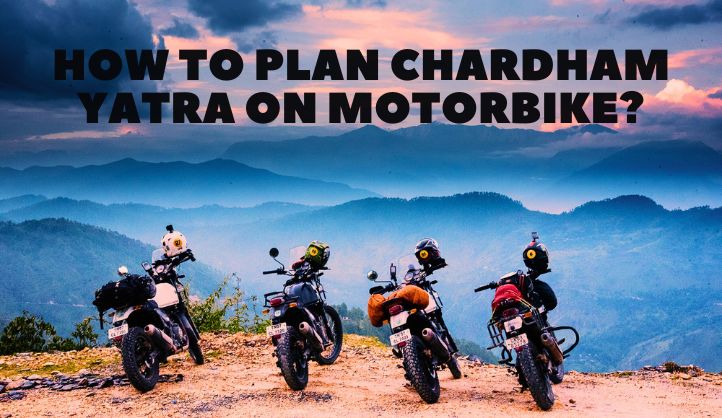How to plan Chardham Yatra on motorbike – Undertaking the Chardham Yatra on a motorbike can be an incredibly rewarding experience, combining pilgrimage with adventure and breathtaking scenery. However, it’s crucial to plan carefully to ensure a safe and enjoyable journey. Here are some key steps to consider:
1. Choose the right time:
The ideal season for a Chardham motorbike trip is generally between April to June and September to October. During these months, the roads are mostly clear of snow and landslides, and the weather is pleasant. However, keep in mind that the monsoon season (July-August) can bring unpredictable weather conditions and road closures.
2. Research and Itinerary Planning:
- Research the four holy sites of Chardham: Yamunotri, Gangotri, Kedarnath, and Badrinath.
- Plan your itinerary considering factors like distance, travel time, and accommodation options at each destination.
- Decide on the route you’ll be taking. There are various routes to Chardham, and each has its own attractions and challenges.
3. Obtain necessary permits and documents:
- Check if any permits are required for traveling through certain areas, especially if you’re a foreign national.
- Carry all necessary documents, such as your driver’s license, vehicle registration, insurance papers, and identification proofs.
4. Choose your bike:
- Select a sturdy and reliable motorcycle suitable for long-distance touring and capable of handling rough terrain. Royal Enfield is a popular choice due to their power and stability. Consider renting a bike if you don’t own one suitable for the journey. Adventure touring bikes or off-road motorcycles are ideal.
- Ensure your bike is well-maintained and serviced before the journey.
4. Plan your route:
- The traditional Chardham Yatra route covers Yamunotri, Gangotri, Kedarnath, and Badrinath. You can customize the itinerary based on your time and preferences.
- Make sure to research road conditions, potential detours, and fuel stops beforehand. Download offline maps for navigation, as internet connectivity might be limited in some areas.
5. Pack essential gear and supplies:
- Pack light but include essentials like toolkits, spare parts, puncture repair kits, first aid kits, basic medicines, extra fuel cans, water bottles, snacks, and appropriate clothing for varying weather conditions.
- It’s advisable to carry a GPS device or maps, especially if you’re traveling through remote areas with limited connectivity.
6. Safety precautions:
- Wear proper riding gear, including helmets, gloves, riding boots, and protective clothing.
- Follow traffic rules and exercise caution, especially on mountain roads, which can be narrow and winding.
- Plan your daily riding schedule to avoid riding at night, as visibility can be poor and wildlife may pose a risk.
7. Be prepared for the weather:
- Mountain weather can be unpredictable, so pack for rain, sunshine, and even snow depending on the season and altitude.
- Carry sunscreen, sunglasses, and lip balm to protect yourself from the sun’s harsh rays.
7. Respect local customs and traditions:
- Dress modestly, especially when visiting religious sites.
- Be mindful of local customs and avoid causing offense.
8. Accommodation Booking:
- Book your accommodations in advance, especially during peak pilgrimage seasons when lodging options may be limited.
- Consider staying in guesthouses, hotels, or ashrams along the route. Camping can also be an option if you have the necessary equipment.
9. Stay Hydrated and Energized:
- Stay hydrated by drinking plenty of water throughout the journey, especially at high altitudes.
- Take regular breaks to stretch, rest, and refuel your body. Carry energy snacks to keep yourself energized during long rides.
10. Respect Local Customs and Environment:
- Respect the religious significance of the Chardham sites and adhere to the local customs and traditions.
- Dispose of waste responsibly and leave no trace of your presence to preserve the sanctity of the pilgrimage sites and protect the environment.
11. Emergency preparedness:
- Familiarize yourself with emergency contact numbers and locations of nearby medical facilities, police stations, and petrol pumps.
- Carry a fully charged mobile phone with emergency contacts saved and consider investing in a portable power bank.
12. Enjoy the Journey:
- While the Chardham Yatra is a spiritual pilgrimage, it’s also an opportunity for adventure and exploration. Take time to soak in the breathtaking landscapes, interact with locals, and enjoy the journey as much as the destination.
Additional Tips:
- Book accommodation in advance; especially during peak season, hotels and guesthouses fill up quickly.
- Carry sufficient cash: Card transactions might not be possible in remote areas.
- Learn some basic Hindi phrases. This will help you communicate with locals.
- Enjoy the ride! Take in the stunning Himalayan scenery and embrace the unique experience of a Chardham motorbike yatra.
Conclusion
Remember, undertaking the Chardham Yatra on a motorbike requires physical fitness and a good understanding of the challenges involved. Ensure you’re well-prepared and prioritize safety throughout your journey.
FAQs Related to How to Plan Chardham Yatra on a Motorbike?
Q: What are the road conditions like during the Chardham Yatra?
Road conditions vary along the route, with some sections being well-paved and others more rugged and challenging, especially in mountainous areas. It’s essential to research road conditions beforehand and be prepared for diverse terrain.
Q: Is it safe to undertake the Chardham Yatra on a motorbike?
While the journey can be adventurous, safety should be a priority. Ensure your bike is well-maintained, wear appropriate safety gear, follow traffic rules, and exercise caution, especially on mountain roads.
Q: Are there medical facilities available along the route?
Medical facilities may be limited in remote areas, so it’s essential to familiarize yourself with the locations of nearby hospitals or clinics. Carry a first aid kit and necessary medications, and know emergency contact numbers.
Q: What should I do in case of inclement weather or unforeseen circumstances?
Stay updated on weather forecasts and road conditions. Have a contingency plan in place, such as alternative routes or accommodations. It’s also advisable to carry emergency supplies and maintain communication with a trusted contact.
Q: Can I travel solo, or is it better to join a group for the Chardham Yatra?
Solo travel is possible, but traveling in a group can offer additional safety and support, especially in remote areas. Whether solo or in a group, ensure you have adequate preparation and contingency plans in place.





